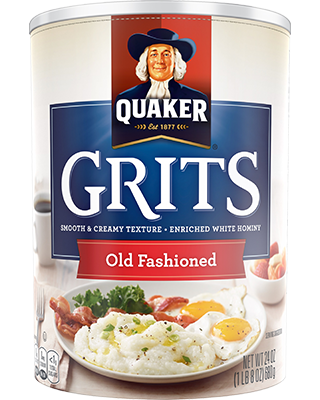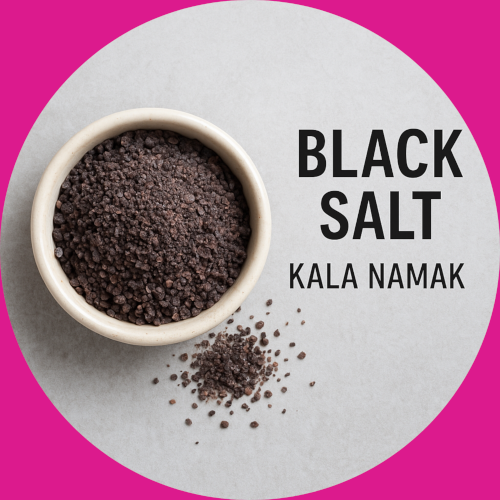Some mornings call for a quick protein shake and a banana. Others? Well, they deserve a little ceremony. This bowl is for the latter — a deeply savory, Maryland-inspired breakfast that manages to feel indulgent while still supporting your goals. We call it the chesapeake bay breakfast bowl, and it all started with one question: What if we could eat grits, eggs benedict style, for breakfast and not hate ourselves afterwards?
The answer? A warm, comforting bowl layered with creamy grits, a seared crab cake, garlicky greens, protein-rich toppings, and a bright, savory cottage cheese-based hollandaise we affectionately call faux-landaise. Oh — and a crisp/salty Old Bay gremolata from smashed saltines. Because we’re fancy over here.
the players: choosing ingredients that hit all the right notes
Here is how we landed on each element.
grits
Because I’m a transplanted Southerner (no, Maryland is not the South, thankyouverymuch), I need regular doses of this warm, classic comfort food. Grits have it all — they’re creamy, rich, savory, and filling, even in a small serving.
If you “don’t like grits,” first… I’m sorry for your loss. Second, are you sure you’ve had them properly prepared? Because I will say that I have ordered them dozens of times in the nearly 16 years I’ve lived in Maryland, and I have never once had a decent bowl in a restaurant. Beyond the fact that they’re not really popular here, there’s another, quite understandable reason: grits don’t hold well. Like, at all. Don’t get me wrong: there are lots of things you can do with leftover grits. But since they take a while to make properly and need to be kept warm in quantity for smooth restaurant service, cooks wind up having to constantly add liquid and/or stir to keep them ready to plate… which leads to watery, clumpy, starchy gloop that I don’t blame folks for rejecting.
But as any grits lover will tell you, it’s worth it to learn the right way to cook them so that they fulfill all their delicious, cozy, warming potential. They really are a different thing altogether when done right.

When trying your hand at making them, please follow a couple of my hard and fast rules suggestions:
- Never use instant grits. Not under any circumstances. That way lies sorrow and disappointment. You can’t get them creamy, they taste flat, and they’re just a sad little product with none of the joy. If this is your only option, I’d advise you to skip them and have mashed potatoes or something instead.
- Avoid the “quick 5-minute” variety unless they’re your only option. These take only marginally less time than old fashioned grits, honestly, and the quality gap between them is quite large.
- Start with hominy grits. While stone ground grits are arguably better in “quality and nutritional value” than Quaker’s Old Fashioned Grits, they are less well suited to this recipe. And honestly, hominy grits are what I grew up with and what I still prefer; they cook up smooth, cozy, and spoonable and are a perfect base here to hug your other ingredients sauce in a warm, delicious, embrace. Stone ground grits take far longer to cook, will always retain some “chew,” and require practice, patience, or and/or luck to get right. They can be acceptable in “rustic” dishes or when baked, as in a casserole (I guess), but for a grits newbie, hominy grits are probably a better gateway to their innate lusciousness.
- Cook them right. In light of all this, please, for the love of all that is comforting, learn to make grits properly, no matter which variety you choose. Please. If you don’t know how, ask a Southern cook. We will happily guide you to creamy grits greatness. I’m not saying folks from the West Coast or New England can’t pull it off, of course — many can, absolutely. But if grits have never been on your culinary radar, chances are you never even thought to learn. The good news? You can fix that! Start by learning to make them my way — right here.***
*** NOTE: The reason I don’t include complete instructions for how to make the grits as part of this recipe is simple: stone-ground grits are often easier to find these days, but they behave very differently from hominy grits — and they’re not interchangeable. I’ve learned (the hard way) that folks sometimes confuse the two, or try to cook one like the other… and the results? Usually disappointing. Since this recipe is built specifically around hominy-style grits — like Quaker Old Fashioned — I’ve kept the how-to separate to make sure you get the creamy, dreamy results you deserve. I’ll show you exactly how I make them right here — even the (inferior) trendy kind — step by step.
crab cake
But back to the bowl. We knew we wanted something a little decadent, but not deep-fried or filler-packed. Our crab cakes are lean and loaded with flavor and held together with just enough binder to stay juicy without feeling heavy. We swapped in a touch of cottage cheese and used Dusseldorf mustard for its mellow heat.
the egg(s)
We love a good poached egg, but for this bowl, I wanted something fast, creamy, and easy to prep in advance. Enter: faux eggbeaters. Our custom egg mix made from egg whites, whole eggs, mustard, nutritional yeast, and a secret or two (👀 black salt, we’re looking at you) delivers that rich, savory flavor and a silky texture, all while trimming the fat. But as with (almost) everything in the kitchen, you do you. Scramble, poach, fry, fold, baste — whatever. If you like it, it belongs here.
faux-landaise sauce
Traditional hollandaise is divine, but let’s be honest — butter, egg yolks, and whisking over a double boiler aren’t exactly diet- or weekday-friendly. Instead, we blended cottage cheese, mustard, lemon juice, and a bit of nutritional yeast into a smooth, tangy sauce that tastes shockingly indulgent. It’s creamy, zippy, and full of protein. No egg-wrangling required.
sautéed greens
While I suppose greens are usually steamed through or even just wilted for power bowls, I love tasty sautéed spinach and chard so much that I use my savory kind-of-creamed greens recipe here. Feel free to prepare yours however you like, though (obviously!)
old bay saltine gremolata
Yes, we made a gremolata with saltines. And it slaps. A crispy, punchy (slappy?) topping with parsley, lemon pepper, and Old Bay to bring the whole dish home to the Chesapeake. It’s salty, citrusy, and gives the dish just enough texture to keep every bite interesting.
how to build the chesapeake bowl
This is almost more of a blueprint than it is a recipe, and once you know how it works, you can riff on it endlessly. Here’s the basic structure, plus why each element matters.
start with a creamy, starchy base
Grits are my choice (obviously), but polenta, mashed potatoes, or even savory oatmeal could work here.
add a protein centerpiece
A crab cake (and Old Bay) give this bowl its name, but shrimp or fish work beautifully here, too. Not into seafood? No problem — plenty of other options play well here. Want something more traditional “breakfasty” option? Try scrapple, bacon, or sausage — smoked, breakfast style, andouille, brats, even bangers. It all works.
And if you’re going meatless, you could choose seared tofu, slow-cooked black-eyed peas or beans, or one of the many solid meatless alternatives out there. In addition to the obvious protein boost, meat brings texture, substance, and that umami flavor for that “main event” energy. Something with a little sear makes the bowl feel special.
Tip: Top with flaked dry-smoked salmon and capers for a Chesapeake/Scandi mashup.
layer in greens for flavor and contrast
Greens keep things bright and grounded. Their slight bitterness balances the richness of the grits and sauce. If you’re short on time, check the freezer section of your grocery store for a plethora of steam- or microwave-ready spinach, kale, collards, or mixed greens. While I prefer to cook down fresh greens when I can, you had better believe I’m never without some of these convenient alternatives in my frezer for sudden turnip green cravings! And they pull their weight in this recipe.
add a tangy sauce
You have a lot of options here — it really just depends on the vibe you’re going for. It may edge you out of Maryland territory, but you can absolutely switch up the sauce to switch up the whole mood. As long as it adds richness and zing, you’re golden. Stick with what you know (remoulade? ranch?) or branch out (chili crisp is amazing!)
Honestly, the flavors here stand on their own just fine, but it takes things up a notch (or several) when you have something to tie it all together.
Tip: If you make your sauce ahead of it thickens too much, just add a splash of your milk of choice or lemon juice to loosen it back up.
bring in some texture
The gremolata in this recipe does more than act as a flavor booster and make it look pretty; it also breaks up the otherwise smooth mouthfeel. Crunch is non-negotiable in my book; it keeps each bite from feeling “same-y” and gives the dish character.
Tip: Besides the gremolata, you could try crispy shallots, toasted breadcrumbs, roasted chickpeas, or even those little french-fried onions that are so ubiquitous in holiday meals. Just don’t skip the seasoning; that last sprinkle can make the whole thing pop!
top with eggs (or not)
Poached, fried, scrambled, soft-cooked, or even an egg white omelet — or just skip them if you’ve already got enough protein in the bowl. But adding an egg does bring silkiness, flavor, and (of course) protein. And let’s be real: a runny yolk broken over a bowl of grits is a moment on its own!
Tip: Add a pinch of black salt — and I do mean a pinch! It deepens the eggy flavor, which is especially helpful if you’re working with a low-fat mix, using straight-up egg whites, or if you just want that extra oomph. But go easy; too much, and it will quickly tip from savory to sulfurous.
make it yours
Don’t have crab? Use chickpea patties! Hate mustard? Try a dollop of yogurt and a sprinkle of lemon juice. Love spice? Add the previously aforementioned mighty chili crisp. This bowl doesn’t judge.
The magic of the Chesapeake bowl is how easily it adapts to your mood, your fridge, and your macros. Once you know the structure, you can riff, remix, and reinvent it anytime.

